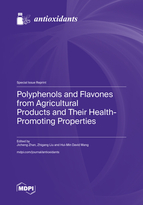Polyphenols and Flavones from Agricultural Products and Their Health-Promoting Properties
A special issue of Antioxidants (ISSN 2076-3921). This special issue belongs to the section "Natural and Synthetic Antioxidants".
Deadline for manuscript submissions: closed (30 September 2022) | Viewed by 44616
Special Issue Editors
Interests: grape; blueberry; mulberry; polyphenols; obesity; cancer; diabetes; gut microbiome
Interests: nutritional intervention; polyphenols; metabolic syndrome; aging; brain health; gut–brain axis; Alzheimer’s disease
Interests: tissue engineering; regenerative medicine; drug design; cancer research; food chemistry; dermatology; biochemistry; chemical engineering; proteomics; molecule biology; marine biotechnology & resources
Special Issues, Collections and Topics in MDPI journals
Special Issue Information
Dear Colleagues,
Polyphenol and flavone compounds have received considerable attention for their health-promoting properties in many chronic disorders, including diabetes, cardiovascular diseases, cancer diseases, neurodegenerative diseases, etc. Lots of studies have also shown that it was the polyphenols and flavones which contributed more to the health-promoting properties of agricultural products. Recently, attention has been focused on polyphenols and flavones and their derivatives, and their supplementation can truly reduce the risk of some diseases. The health-promoting properties of polyphenols and flavones have been a hot research field.
We invite you to submit your latest research articles, review articles, and short communications that help to highlight the most recent advances on polyphenol extracts from agricultural products, and their role in health-enhancing benefits. For manuscripts which contain mixture compounds extracted from agricultural products, the characterization (using analytical methodologies, such as HPLC, MS, LC–MS, HPLC–MS, and NMR) of the active chemicals in natural compound should be included.
We look forward to your contributions.
Prof. Dr. Jicheng Zhan
Prof. Dr. Zhigang Liu
Prof. Dr. Hui-Min David Wang
Guest Editors
Manuscript Submission Information
Manuscripts should be submitted online at www.mdpi.com by registering and logging in to this website. Once you are registered, click here to go to the submission form. Manuscripts can be submitted until the deadline. All submissions that pass pre-check are peer-reviewed. Accepted papers will be published continuously in the journal (as soon as accepted) and will be listed together on the special issue website. Research articles, review articles as well as short communications are invited. For planned papers, a title and short abstract (about 100 words) can be sent to the Editorial Office for announcement on this website.
Submitted manuscripts should not have been published previously, nor be under consideration for publication elsewhere (except conference proceedings papers). All manuscripts are thoroughly refereed through a single-blind peer-review process. A guide for authors and other relevant information for submission of manuscripts is available on the Instructions for Authors page. Antioxidants is an international peer-reviewed open access monthly journal published by MDPI.
Please visit the Instructions for Authors page before submitting a manuscript. The Article Processing Charge (APC) for publication in this open access journal is 2900 CHF (Swiss Francs). Submitted papers should be well formatted and use good English. Authors may use MDPI's English editing service prior to publication or during author revisions.
Keywords
- polyphenols
- flavones
- antioxidant
- obesity
- cancer
- diabetes
- neurodegenerative diseases
- brain health
- gut–brain axis
- gut microbiome









